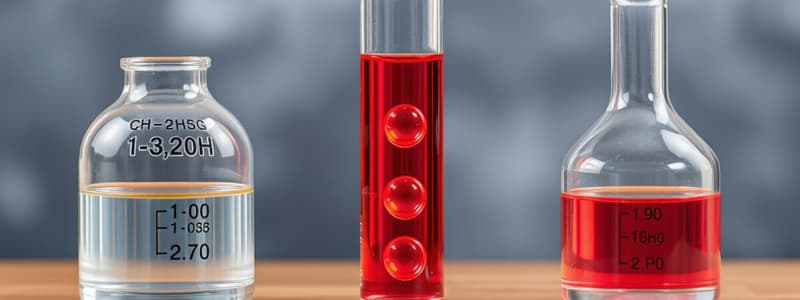Podcast
Questions and Answers
Balance the equation: __Na + __F₂ → __NaF
Balance the equation: __Na + __F₂ → __NaF
2, 1, 2
Balance the equation: __Na + __MgF₂ → __NaF + __Mg
Balance the equation: __Na + __MgF₂ → __NaF + __Mg
2, 1, 2, 1
Classify the reaction: Na + F₂ → NaF
Classify the reaction: Na + F₂ → NaF
Synthesis/Combination reaction
Classify the reaction: AgBr → Ag + Br₂
Classify the reaction: AgBr → Ag + Br₂
Classify the reaction: Na + MgF₂ → NaF + Mg
Classify the reaction: Na + MgF₂ → NaF + Mg
Balance the equation: __BaCl₂ + __Na₂SO₄ → __NaCl + __BaSO₄
Balance the equation: __BaCl₂ + __Na₂SO₄ → __NaCl + __BaSO₄
Classify the reaction: BaCl₂ + Na₂SO₄ → NaCl + BaSO₄
Classify the reaction: BaCl₂ + Na₂SO₄ → NaCl + BaSO₄
Balance the equation: __Sn + __HF → __SnF₂ + __H₂
Balance the equation: __Sn + __HF → __SnF₂ + __H₂
Balance the equation: __Fe + __O₂ → __Fe₂O₃
Balance the equation: __Fe + __O₂ → __Fe₂O₃
Balance the equation: __CS₂ + __O₂ → __CO₂ + __SO₂
Balance the equation: __CS₂ + __O₂ → __CO₂ + __SO₂
Balance the equation: __CH₄ + __O₂ → __CO₂ + __H₂O
Balance the equation: __CH₄ + __O₂ → __CO₂ + __H₂O
Classify the reaction: CH₄ + O₂ → CO₂ + H₂O
Classify the reaction: CH₄ + O₂ → CO₂ + H₂O
What is a chemical substance that is present at the start of a chemical reaction?
What is a chemical substance that is present at the start of a chemical reaction?
What is a chemical substance formed as a result of a chemical reaction?
What is a chemical substance formed as a result of a chemical reaction?
What represents a chemical reaction that uses symbols to show the relationship between the reactants and products?
What represents a chemical reaction that uses symbols to show the relationship between the reactants and products?
What is the process during which chemical bonds between atoms are broken and new ones are formed?
What is the process during which chemical bonds between atoms are broken and new ones are formed?
What does an arrow in a chemical equation signify?
What does an arrow in a chemical equation signify?
During any chemical reaction, the mass of the products is always equal to the mass of the reactants.
During any chemical reaction, the mass of the products is always equal to the mass of the reactants.
What is a number in front of a chemical formula that indicates how many molecules or atoms of each reactant and product are involved in a reaction?
What is a number in front of a chemical formula that indicates how many molecules or atoms of each reactant and product are involved in a reaction?
What is a number written slightly below and to the right of a chemical symbol that shows how many atoms of an element are in a compound?
What is a number written slightly below and to the right of a chemical symbol that shows how many atoms of an element are in a compound?
What does it mean to keep the mass of products and reactants the same by adjusting coefficients?
What does it mean to keep the mass of products and reactants the same by adjusting coefficients?
Study Notes
Balancing Chemical Equations
- Balancing equations ensures the conservation of mass, meaning the mass of reactants equals the mass of products.
- Coefficients are used in front of chemical formulas to represent the number of molecules or atoms involved in the reaction.
- Subscripts indicate the number of atoms of each element in a compound and cannot be changed when balancing equations.
Types of Chemical Reactions
- Synthesis/Combination Reaction: Two or more reactants combine to form one product (e.g., Na + F₂ → NaF).
- Decomposition Reaction: A single compound breaks down into two or more products (e.g., AgBr → Ag + Br₂).
- Single Replacement Reaction: An element replaces another in a compound (e.g., Na + MgF₂ → NaF + Mg).
- Double Replacement Reaction: The ions of two compounds exchange places to form two new compounds (e.g., BaCl₂ + Na₂SO₄ → NaCl + BaSO₄).
- Combustion Reaction: A substance reacts with oxygen, producing energy, carbon dioxide, and water (e.g., CH₄ + O₂ → CO₂ + H₂O).
Key Definitions
- Reactant: A substance that participates in a chemical reaction, present at the start.
- Product: A substance formed as a result of a chemical reaction.
- Chemical Equation: Symbolic representation of a chemical reaction showing the relationship between reactants and products.
- Chemical Reaction: Process of breaking and forming chemical bonds to create different substances.
- Yields: The arrow in a chemical equation indicating that products are produced from reactants.
- Law of Conservation of Mass: States mass remains constant in a closed system during a chemical reaction.
- Coefficient: Indicates the number of molecules or atoms in a reaction, placed before the chemical formula.
- Subscript: A small number indicating the quantity of a particular atom in a compound.
Balancing Techniques
- Adjust coefficients strategically to balance the number of atoms of each element on both sides of the chemical equation.
- Use systematic approaches or trial-and-error methods to achieve balanced equations while preserving subscripts.
Studying That Suits You
Use AI to generate personalized quizzes and flashcards to suit your learning preferences.
Description
Test your knowledge on balancing chemical equations and classifying various types of chemical reactions. This quiz includes flashcards that challenge you to identify and write the correct stoichiometric coefficients and reaction types. Perfect for chemistry students looking to reinforce their understanding of these fundamental concepts.




